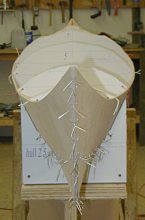 |
Now
open the big picture and check out the laser precision of the deck centerline
as it aligns with the bow and stern tip! Note that this is solely due to
the effort that went into having the strongback and external hull stations
nicely level.
OK, also notice the "unfair" plate edge between station 2.5 and
5 on the left side. Despite the "loose plate edge fairness" rule
from the previous page, what can be the cause? First, both plates were cut
at the same time so they are identical and the stations are also perfectly
symmetrical so size or shape is not likely the problem. One definite possibility
could be a scarf between the stations which alters the bending properties
at that section. Another possibility is the grain orientation of the plywood
- even though both plates are of the same size and shape, they are not cut
from the same section of plywood. The grain orientation on the opposite
plates can be significantly different and it probably is since the plates
are cut as mirror images of each other and may come from a different plywood
sheet. Yet another significant possibility ( and I believe that is the true
cause) is the amount of force that the plate is wired to the adjoining stations.
Note that the plates do not fall flat on the station edge but only on one
edge. Over-tightening the wire will crate a sharp bend at the station
which seems to be the case here. Nevertheless, the addition of the first
deck plate will completely cure this problem. |

